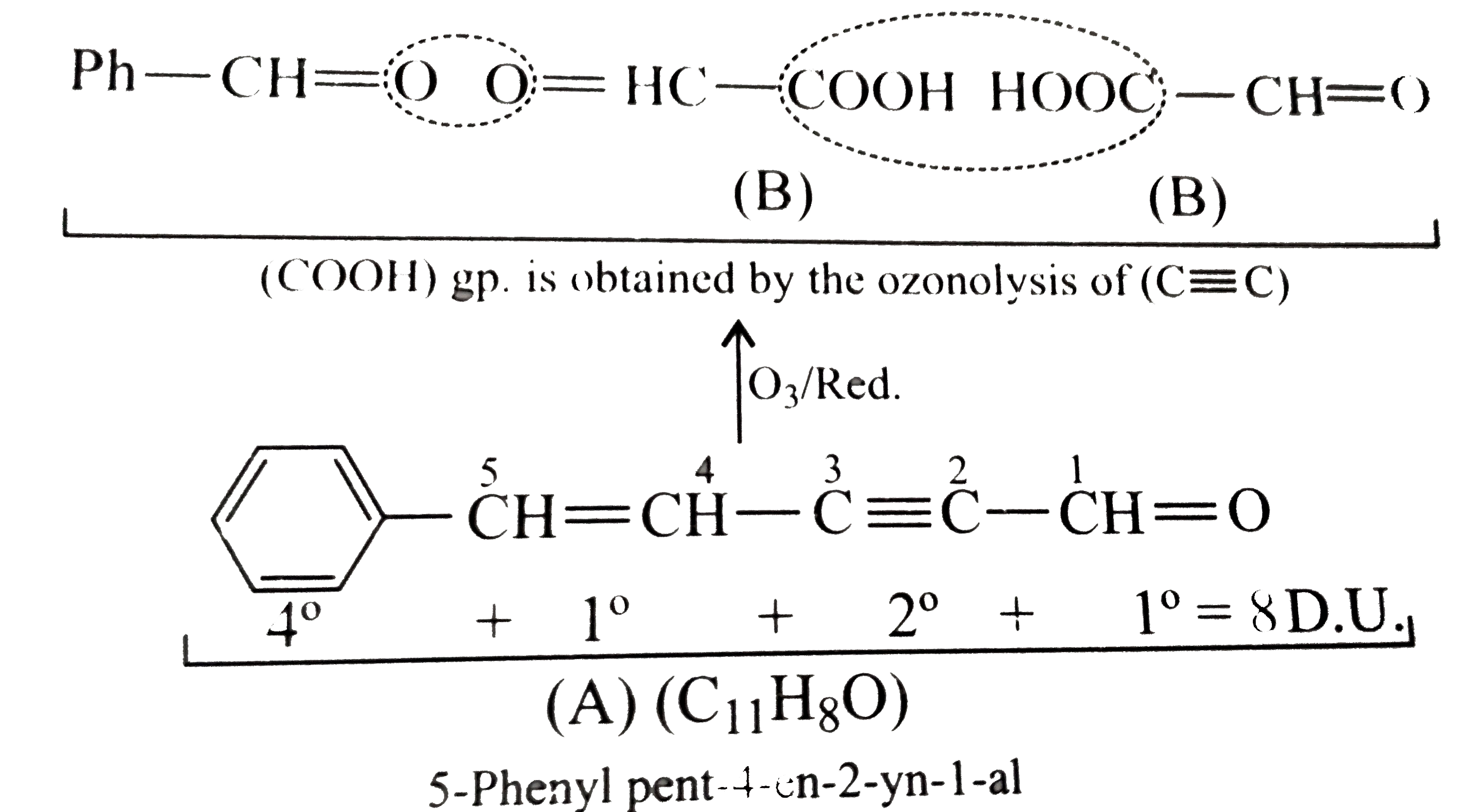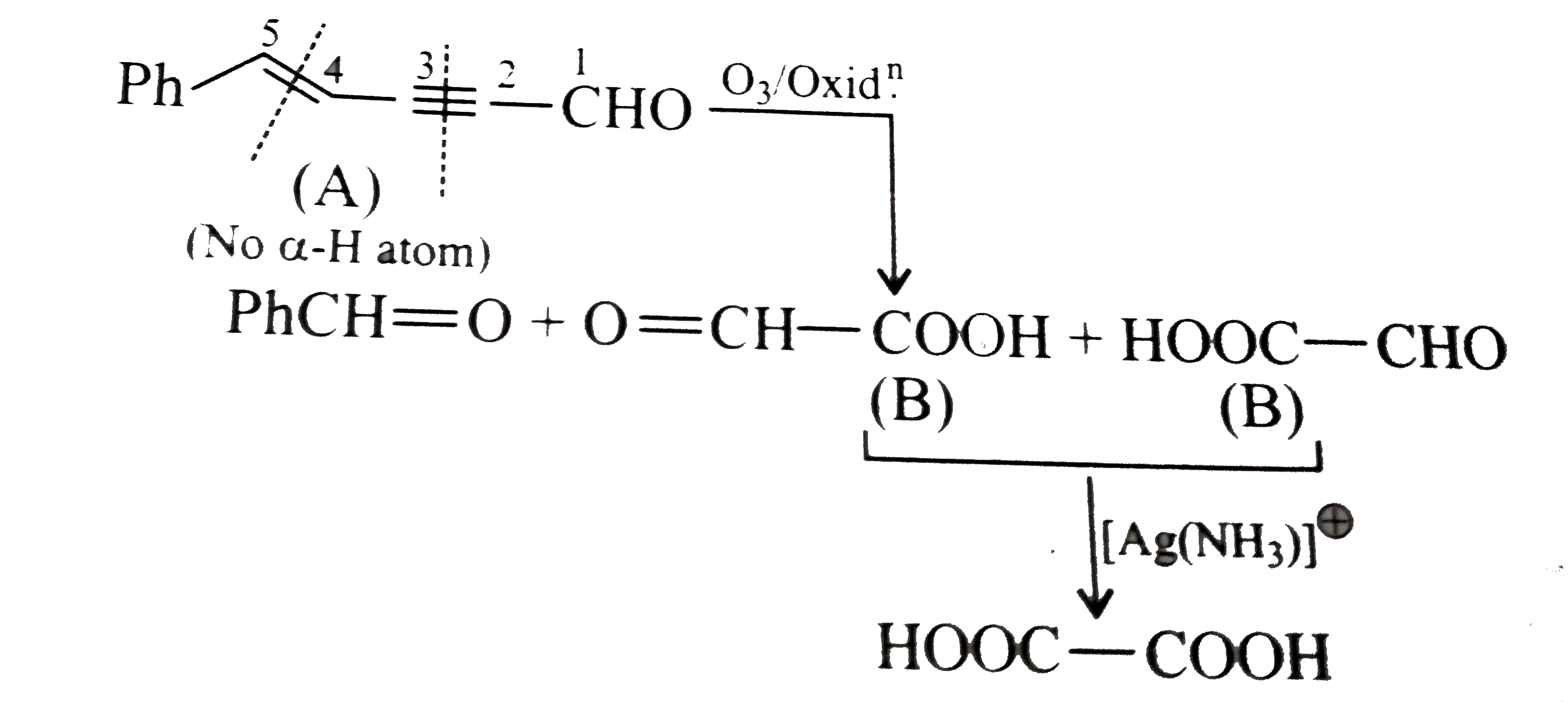An aldehyde (A) (C11H8O), which does not undergo self aldol condensation, gives benzaldehyde and 2 mol of (B) on ozonolysis. Compound (B) on oxidation with silver ion gives oxalic acid. Identify the compounds (A) and (B).

(Tollens reagent oxidises (−CHO) group to (COOH) group, without breaking (C=C) or (C=C) or (C≡C) bond.
compound (B) is CHO∣COOH (Glyoxalic acid).
Proceed reverse to obtained the structure of (A).

Reactions:

Topper's Solved these Questions
- ALIPHATIC AND AROMATIC ALDEHYDES AND KETONESBOOK - CENGAGE CHEMISTRYCHAPTER - ALIPHATIC AND AROMATIC ALDEHYDES AND KETONESEXERCISE - Archives Linked Comprehension
6 Videos
- ALCOHOL,PHENOL AND ETHERSBOOK - CENGAGE CHEMISTRYCHAPTER - ALCOHOL,PHENOL AND ETHERSEXERCISE - Archives Analytical And Descriptive
15 Videos
- AMINESBOOK - CENGAGE CHEMISTRYCHAPTER - AMINESEXERCISE - QUESTION BANK
1 Videos
Similar Questions
An aldehyde (A) (C11H8O) , which does not undergo self aldol condensation, gives benzaldehyde and two moles of (B) on ozonolysis.Compound (B), on oxidation with silver ion, gives oxalic acid. Identify the compounds (A) and (B).
View SolutionA compound C9H7O2CI exists predominanthly in enol from (A) and also in keto from (B) On oxideation withKMnO4 it gives m-chlorobenzoic acid as one of the products. Identify the compounds (A) and (B).
View Solution
Knowledge Check
Compound A (ester ) reacts with LiAlH4 gives B and C. Compound B on oxidation gives acetic acid and compound C on oxidation gives formic acid. The compound 'A' is
AC2H5−COOCH3BCH3COOC2H5CCH3−COOCH3DCH3−CH2−COOHAn organic compound (A), C2H5NO2 gives on reduction another compound (B) C2H7N. The reaction of nitrous acid on (B) evolves nitrogen and gives another compound (C) C2H6O. The compound (C) on oxidation gives acetic acid. The compounds A, B, C are
ANitroethane, Ethylamine, Ethyl alcoholBNitroethane, Dimethylamine, Ethyl alcoholCNitroethane, Dimethylamine, AcetoneDNoneA compound 'X' on ozonolysis followed by reduction gives an aldehyde, C2H4O and 2-butanoic. Compound 'X' is:
A3-methylpent-2-eneB3-methylpent-3-eneC3-methylhex-3-eneD3-ethylpent-3-ene
A hydrocarbon (A) of the formula C7H12 on ozonolysis gives a compound (B) which undergo aldol condensation giving 1-acetylcyclopentene. Identify (A) and (B).
View SolutionA hydrocarbon (A) of the formula , C7H12 on ozonolysis gives a compound (B) which undergoes aldol condensation giving 1-acetylcyclopentene. Identify (A) and (B).
View SolutionCompound (A) of molecular formula C9H7O2Cl exists in ketoform and predominantly in enolic form (B). On oxidation with KMnO4, (A) gives m-chlorobenzoic acid. Identify (A) and (B).
View SolutionAn organic compound (A) (C6H10O) on reaction with CH3MgBr followed by acid treatment gives compound (B). The compound (B) on ozonolysis gives compound (C ), which in the presence of a base gives 1-acetyl cyclopentane (D). The compound (B) on reaction with HBr gives compound (E ). Write the structures of (A), (B), (C ), (D), and (E ). Show how (D) is formed from (C ).
View SolutionAn compound (A) which undergo halogorm reaction give compound (B) on reduction . Compound (B) on dehydration with conc. H2SO4 gives compound ( C ) which forms secondary butylbromide with HBr. Identify (A).
View Solution
